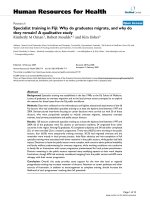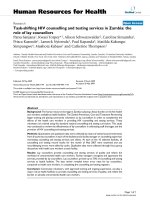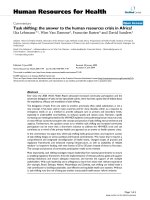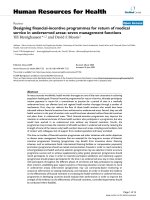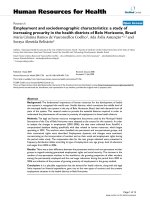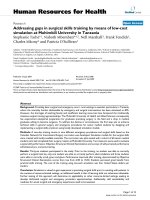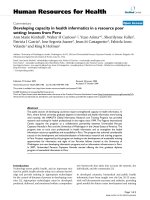báo cáo sinh học:" Task shifting in Mozambique: cross-sectional evaluation of non-physician clinicians’ performance in HIV/AIDS care" pdf
Bạn đang xem bản rút gọn của tài liệu. Xem và tải ngay bản đầy đủ của tài liệu tại đây (286.73 KB, 9 trang )
RESEARC H Open Access
Task shifting in Mozambique: cross-sectional
evaluation of non-physician clinicians’
performance in HIV/AIDS care
Paula E Brentlinger
1*
, Américo Assan
2
, Florindo Mudender
2
, Annette E Ghee
1
, José Vallejo Torres
3
,
Pilar Martínez Martínez
3
, Oliver Bacon
4
, Rui Bastos
2
, Rolanda Manuel
2
, Lucy Ramirez Li
5
, Catherine McKinney
5
,
Lisa J Nelson
5
Abstract
Background: Many resource-constrained countries now train non-physician clinicians in HIV/AIDS care, a strategy
known as ‘task-shifting.’ There is as yet no evidence-based international standard for training these cadres. In 2007,
the Mozambican Ministry of Health (MOH) conducted a nationwide evaluation of the quality of care delivered by
non-physician clinicians (técnicos de medicina, or TMs), after a two-week in-servic e training course emphasizing
antiretroviral therapy (ART).
Methods: Forty-four randomly selected TMs were directly observed by expert clinicians as they cared for HIV-
infected patients in their usual worksites. Observed clinical performance was compared to national norms as taught
in the course.
Results: In 127 directly observed patient encounters, TMs assigned the correct WHO clinical stage in 37.6%, and
correctly managed co-tr imoxazole prophylaxis in 71.6% and ART in 75.5% (adjusted estimates). Correct
management of all 5 main aspects of patient care (staging, co-trimoxazole, ART, opportunistic infections, and
adverse drug reactions) was observed in 10.6% of encounters.
The observed clinical errors were heterogeneous. Com mon errors included assignment of clinical stage before
completing the relevant patie nt evaluation, and initiation or continuation of co-trimoxazole or ART without indica-
tions or when contraindicated.
Conclusions: In Mozambique, the in-service ART training was suspended. MOH subsequently revised the TMs’
scope of work in HIV/AIDS care, defined new clinical guidelines, and initiated a nationwide re-training and clinical
mentoring program for these health professionals. Further research is required to define clinically effective methods
of heal th-worker training to support HIV/AIDS care in Mozambique and similarly resource-constrained
environments.
Background
In sub-Saharan Africa, the human immunodeficiency
virus (HIV) epidemic has expanded rapidly, access to
antiretroviral therapy (ART) is often inadequate, and
shortages of health workers and i nfrastructure are often
critical [1]. Task-shifting, defined as “a process of delega-
tion of tasks to health workers with lower qualifications,”
is one strategy for increasing the availability of HIV/
AIDS treatment in such environments [2,3]. The World
Health Organization (WHO) recently called for more
research to define standardized methods for health
worker training and to assure quality of care i n support
of task-shifting [3].
In 2004, when the Mozambican Ministry of Health
(MOH) first contemplated task-shifting, Mozambique
estimated that nationwide adult HIV seroprevalence was
16.2%, 1.5 million citizens were infected with HIV, and
the health workforce included only 662 physicians (0.35/
* Correspondence:
1
International Training and Education Center on HIV, Department of Global
Health, School of Public Health , University of Washington, Seattle,
Washington, USA
Full list of author information is available at the end of the article
Brentlinger et al. Human Resources for Health 2010, 8:23
/>© 2010 Brentlinger et al; licensee BioMed Central Ltd. This is an Open Access article distributed under the terms of the Creative
Commons Attribution License ( , which permits unrestricted use, distribution, and
reproduction in any medium, provided the original work is properly cited.
10 000 population) and 2698 non-physician c linicians
(1.43/10 000 population) [4,5]. Mozambique’s strategic
plan for 2004-2008 mandated expansion of ART from
17 to 129 health units, with the aim of increasing
enrolled patients from 7924 to 132 280 nationwide,
and increasing ART availability in rural and peri-urban
areas [5]. Task-shiftin g and de centralization were to be
supported by rapid training and deployment of non-
physician clinicians known as ‘ técnicos de medicina’
(TMs).
Because pre-service training for TMs (30 months’
duration, after completi on of the 10
th
grade) did not yet
include H IV/AIDS content, MOH developed a new in-
service training course. Its curriculum emphasized ART
and co-trimoxazole prophylaxis, with lesser attention
given to clinical staging of HIV/AIDS [6] and to oppor-
tunistic infections (OIs). This reflected the plan’sintent
that TMs only care for stable, uncomplicated, ambula-
tory non-pregnant adults in WHO clinical stages I and
II [6], and that they not initiate ART, although they
were authorized to provide follow-up care fo r stable
patients on first-line antiretrovirals that had been pre-
scribed by physicians. The two-week duration was t he
norm for in-service training in Mozambique. The course
was taught to TMs in all 10 provinces in 2006 and
2007. During this period, policy was changed to author-
ize TMs to initiate first-line ART without physician
consultation. Shortly after the deployment of the first
graduates, MOH received anecdotal reports of deficien-
cies in quality of care, and decided to conduct a nation-
wide evaluation of quality of HIV/AIDS-related care as
provided by TMs.
Objectives
TheaimofthestudywastodevelopaMozambique-
specific evidence base to guide improvements in training
of TMs. The primary objectives were to describe the
extent to which TMs correctly identified the WHO clinical
stage of HIV-infected patients, managed co-trimoxazole
prophylaxis and ART, and diagnosed and managed
adverse drug reactions (ADRs) and opportunistic infec-
tions (OIs). Secondary objectives included qualitative
descriptions of the TMs’ clinical environment (e.g. human
and material reso urce availabili ty), and of health workers’
attitudes toward HIV/AIDS training.
Methods
Study design
This cross-sectional evaluation used direct obse rvation of
the clinical practice of randomly selected TMs, supple-
mented by semi-structured interviews with key infor-
mants. Two trained clinical observers (COs) observed
each TM as he or she cared for HIV-infected ambulatory
adults (> = 18 years) (See Additional File 1 for a
description of th e selec tion and training of the COs). For
each TM, we attempted to observe 3 patient encounters:
1 first visit of a newly diagnosed patient, 1 scheduled fol-
low-up visit, and 1 unscheduled urgent visit. Without
interrupting the consultation, the COs recorded the find-
ings of each medical history and physical exam as con-
ducted by the TM, using standardized instruments. After
the TM completed his or her evaluation, but before the
TM discharged the patient, the COs asked the TM to
report the patient’ s diagnoses a nd WHO clinical stage,
and the proposed plan for management of co-trimoxazole,
ART, OIs, and ADRs. This co nversation took place in
private, out of earshot of the patient. If it was necessary
to co nfirm the TM’ s clinical findings, the COs then
repeat ed some or all of the history, physical examination,
or chart review (also recording their own findings on
standardized instruments). COs and TMs then finalized
the patient care plan in another private discussion, and
the TM communicated the final plan to the patient. The
COs were careful not to express any criticism or dis-
agreement with the TM in the presence of the patient.
On the same day, the COs conducted semi-structured
interviews with the TMs, t heir clinical supervi sors, and
health unit administrators.Theinterviewsfocusedon
TM demographic information, perceived strengths and
weaknesses of the ART course, and the health unit’ s
human and material resources.
Setting
Data collection occurred in Mozambic an public-sector
health facilities in which the TM participants normally
pract iced, in all 10 provinces and in Maputo, the capital
city, from October through December 2007.
Participants
Mozambican TMs who had completed the 2-week in-
service course and were actively managing ART in the
public sector comprised the study population.
MOH and non-governmental organization training
lists, as verified by provincial HIV/AIDS coordinators,
were used to construct a sampling f rame (described in
Additional File 2). TMs located more than 4 hours’
drive from provincial capitals were excluded for logisti-
cal reasons.
TMs who had served as in-service course instruc tors,
or on the study team, were also ineligible. Because very
few TMs provided ART-related services without having
attended the in-service course, no untrained comparison
group was available.
Two urban and 2 rural TMs were randomly selected
in each province, and 4 urban TMs in Maputo City.
Only 1 TM was selected per health unit. Administrators
and clinical supervisors assigned to the selected health
units served as key informants.
Brentlinger et al. Human Resources for Health 2010, 8:23
/>Page 2 of 9
The first eligible patients presenting during each
observation session were asked t o participate; random
sampling of patients was not feasible.
Variables
Correct clinical management was defined as directly
observed clinical performance that conformed to
Mozambican standards as taught in the in-service
course in the opinions of both the COs and the study
team leader, who reviewed all completed clinical obser-
vation instruments with the COs [7].
Correct clinical staging was defined as identification of
WHO clinical stage in conformity with year 2004 WHO
criteria (in effect when the ART course was designed)
[8] or the year 2006 WHO criteria (partially dissemi-
nated at the time of the study) [6]. B ecause staging
required identification of OIs, resource constraints influ-
enced interpretation of this standard. TMs were given
credit for correct performance if they made appropriate
useofavailablediagnosticstudies,andwerenotpena-
lized for not initiating evaluations that were not feasible
in their environments.
Correct management of co-trimoxazole was defined as
initiation or continuation of co-trimoxazole prophylaxis
in patien ts with confirmed HIV infection, WHO clinical
stages 3 or 4 or CD4+ T-lymphocyte (CD4) count <200
cells/mm
3
, and no known allergy to sulfonamides; or
discontinuation of co-trimoxazole in a patient who had
had an adverse drug reaction (ADR) or whose CD4
count was > = 200 cells/mm
3
on the 2 most recent
measurements.
Correct management of ART was defined as initiation
or continuation of the first-line regimen (stavudine
[d4T], lamivudine [3TC], and nevirapine [NVP]) in a
patient with confirme d HIV infection, WHO clinical
stage 4 or CD4 <200 cells/mm
3
, and no contra-indications
to first-line therapy (e.g. pregnancy, active tuberculosis
(TB), ADR, laboratory abnormalities, or unstabilized OI);
or discontinuation o r modification of ART in a patient
who had experienced a significant ADR or developed
another contra-indication to first-line therapy.
Because Mozambican national norms for co-trimoxa-
zole and ART initiation were modified between the
development of the in-service course and the initiation of
the study (the CD4 threshold for initiating co-trimoxazole
increased to 350 cells/mm
3
, and ART eligibility criteria
were expanded to include patients in clinical stage 3 with
CD4 < 350 cells/mm3), TMs whose clinical decisions con-
formed to the new but not to the old norms were also
given credit for correct performance.
Data sources
The clinical observation instruments were adapted from
those used to evaluate Mozambique’ sIntegrated
Management of Childhood Illness (IMCI) program
[9,10] and a Mozambican OI training course [11], and
rec orded findings of the medical history, physical exam,
labora tory results, and the técnicos’ clinical management
decisions for each observed patient (the instrument is
reproduced in Additional file 3).
Descriptions of TM demographic and professional
characteristics and of health unit characteristics were
based on semi-structured interviews with key
informants.
Bias
We attempted to minimize observer bias by using 2
COs for each patient observation. In each 2-observer
team, there was no more than 1 clinician who had
served as an instructor in the ART course for TMs, and
COs were n ot permitted to e valuate TMs whom they
supervised directly. We also used each patient’s clinical
data as recorded on the observation instrument to vali-
date COs’ conclusions. For example, we reviewed the
patient’s clinical stage, medication a llergies, and CD4
count in order to confirm that the TM’s management of
co-trimoxazole was consistent with Mozambican norms,
the patient’s clinical presentat ion, and the CO’s assess-
ment. We attempted to minimize sampling bias by con-
structing the TM sampling frame from multiple,
frequently updated sources.
Sampling
For this descriptive study, we sought a randomized sam-
ple of 44 TMs and their respective heal th units. This
was estimated to be a 21% sample of all MOH health
units with ART capacity. We estimated that a clinical
observation team could visit a maximum of 4 health
units in a single week of field work. We did not prepare
a formal power calculation because no prior data
described the frequency of clinical errors in this setting.
Random-number t ables were used to guide sele ction of
TMs from each province’ s list of trained, practicing
TMs.
Statistical methods
Quantitative analyses described the proportion of patient
encounters in which each primary clinical domain (sta-
ging, co-trimoxazole, ART, ADRs, or OIs) was managed
correctly by the TM, as recorded by COs. Sampling
weights (calculated sepa rately for each province) were
used to reflect the probability of selection of each TM,
and robust confidence intervals were calculated to
reflect likely correlation of results for patients attended
by the same TM [12]. It was not possible to adjust for
the total n umber of HIV-infecte d patients under each
TM’s care, because patients were not assigned to speci-
fic clinicians’ panels.
Brentlinger et al. Human Resources for Health 2010, 8:23
/>Page 3 of 9
We also constructed a dichotomized composite vari-
able representing TM and CO concordance in all 3 of
the following domains: clinical staging, co-trimoxazole
management, and ART management. Using logistic
regression, we calculated odds ratios (ORs) and their
95% confidence intervals (CIs) for association of TM,
health unit, and patient characteristics and this indicator
of correct diagnosis and management in both bivariate
and multivariate analyses. To account for correlation
between patients seen by the same TM, we used the
robust sandwich estimate of standard error around odds
ratios reported.
Ethical considerations
The study protocol was approved by the Mozambican
National Bioethics Committee. Secondary data analysis
was authorized by the University of Washington Human
Subjects Division. This study also underwent review at
the Centers for Disease Control and Prevention, where
it was deemed to be a non-research program evaluation.
Participating MOH staff (TMs, clinic managers and clin-
ical supervisors) gave written informed co nsent. Patients
gave oral consent. TM and patient data were
confidential.
Clinical mentoring by t he COs was incorporated into
the protocol based on the ethical principle of benefi-
cence, and allowed patients to benefit directly from clin-
ical observer correction of clinical omissions or
mistakes. Immediate clinical feedback was also of benefit
to the TMs themselves.
Results
Description of the sample
Six hundred and sixty-nine técnicos were initially
reported to have received ART training. After inspection
of training lists and consultation with provincial HIV/
AIDS coordinators, 53% of these names were discarded
(25% duplicates, 21% not a ctive in H IV/AIDS clinical
care, 1% not trained in ART, 6% other reasons). We
were often unable to ascertain the status of TMs sta-
tioned in remote rural districts.
No eligible and available TM refused to participate. The
characteristics of the observed TMs and the health units
at which they practiced are described in Tables 1 and 2.
We observed 127 patient consultations (3 per TM,
except in 5 health units with low caseloads). The char-
acteristics of the observed patients are given in Table 3.
Main results
We observed a broad range of clinical practic e quality.
Table 4 describes concordance between clinical observers
and TMs in 5 major domains: staging (37.6% agre ement),
co-trimoxazole management (71.6% agreement), ART
management (75.5% agreement), ADR management
(69.7% agreement), and diagnosis of OIs and other infec-
tious diseases (49.1% agreement). In 89.4% of observed
encounters, the COs disagreed with the TMs about diag-
nosis or management in one or more of these domains.
In all cases, the level of agreement was significantly dif-
ferent from 100%.
Staging and opportunistic infections
Differences of opinion between COs and TM s were of
three main types: Understaging (miscategorizing a
patient as having less advanced disease), overstaging
(miscategorizing a patient as having more advanced dis-
ease), and premature staging (assigning a clinical stage
before completing the indicated clinical and laboratory
evaluations). Correct staging is predicated on correct
identification of OIs, which was difficult in this
reso urce-constrained setting. In particular, Stage IV OIs
could be diagnosed only infrequently. Examples of sta-
ging difficulties are described in Additional file 4.
Co-trimoxazole prophylaxis, antiretroviral therapy
Disagreements were of 2 main types: initiation or conti-
nuation of medications when not indicated, and failure
to initiate or continue when co-trimoxazole and/or ART
were indicated. Examples are given in Additional files 5
and 6.
Adverse drug reactions
ADRs were confirmed by the CO in 20 patients (15.7%),
and were often under-diagnosed or under-treated by the
TMs. Examples are given in Additional file 7.
Correlates of correct management
Bivariate and multivariate analyses revealed three princi-
pal correlates of correct patie nt management (defined as
concordance in the three principal domains of staging,
co-trimoxazole management, and ART management). In
multivariate analyses, increasing ART caseloads at the
TM’s home health unit were positively correlated with
correct performance in all 3 domains (OR per additional
patient on ART per month 1.001 [95% CI 1.000, 1.002]),
while increasing TM age and the presence of any sign
or symptom of TB or of confirmed TB were both nega-
tively associated with correct perfo rmance (OR per year
of TM age 0.896 [95% CI 0.831, 0.965]; OR if patient
had confirmed or suspected TB 0.132 [95% CI 0.019,
0.936]). No other observed characteristic of patients,
TMs, or health units was significantly associated with
‘correct’ performance.
Discussion
Key results
We found that, in the majority of observed pat ient
encounters, Mozambican non-physician clinicians who
Brentlinger et al. Human Resources for Health 2010, 8:23
/>Page 4 of 9
had received brief in-service HIV/AIDS training did not
adhere to Mozambican national clinical standards as
taught in their course. These assessments were based on
direct observation of patient care by experienced clini-
cians familiar with the Mozambican clinical environ-
ment. Although some errors were unlikely to have had
adverse effects on patient outcomes, others were more
serious, and even life-threatening. However, we also
observed TMs who provided excellent patient care.
Better TM performance was correlated with younger
TM age, the absence of confirmed TB or TB symptoms
in the observed patients, and higher ART caseloads at the
TMs’ home health facilities. T he younger TMs may have
performed better because they began their pre-service
Table 1 Description of participating técnicos de medicina (n = 44)
Characteristic (n = 44) N (%) Median (Range) Missing
Age (years) 30 (23-64) 1
Female 14 (32.6%) 1
Years since completion of pre-service training 5.5 (0.5-24.5) 2
Months since completion of in-service ART training 13 (3-24) 2
Also completed in-service course on opportunistic infections 24 (54.6%) 0
Months of experience providing ART 14 (4-80) 2
Number of patients on ART seen in health unit during month prior to study 145 (9-2090) 4
Number of patients started on ART by TM during preceding month 12 (3-60) 5
Notes:
ART: antiretroviral therapy.
TM: técnico de medicina.
Table 2 Description of participating health units (n = 44)
Characteristic N (%) Median (range) Missing
Urban 22 (50.0%) 0
Months since health unit introduced ART 21 (1-71) 5
Number of ART-related patient encounters during most recent month 145 (9-2090) 4
TM’s tasks include:
Staging 37 (88.1%) 2
Initiate co-trimoxazole 38 (90.5%) 2
Request CD4 count 36 (87.8%) 3
Request other labs 39 (95.1%) 3
Diagnose and treat OI 40 (97.6%) 3
Initiate ART 38 (90.5%) 2
In-hospital care for patients on ART 18 (46.2%) 5
Laboratory and imaging capacity (on-site availability of test)
CD4 count 6 (14.6%) 3
Complete blood count 30 (75.0%) 4
Transaminases 19 (48.7%) 5
Hemoglobin 37 (88.1%) 2
Sputum smear microscopy for detection of acid-fast bacilli 41 (97.6%) 2
CSF cell count 20 (55.6%) 8
CSF india ink preparation 15 (39.5%) 6
Rapid malaria test 42 (97.7%) 1
Chest radiograph 14 (35.0%) 4
Notes:
ART: antiretroviral therapy.
CD4 count: CD4+ T-lymphocyte count.
CSF: cerebrospinal fluid.
OI: opportunistic infection.
TM: técnico de medicina.
Brentlinger et al. Human Resources for Health 2010, 8:23
/>Page 5 of 9
training after pre-service f aculty had begun to acquire
expertise of their own in HIV/AIDS care. Worse TM per-
formance when faced with TB patients or TB suspects
may be the result of Mozambican policy restricting TB/
HIV co-infection care to physicians; or may be a marker
for worse performance in the presence of symptomatic
patients in general. Better performance in health facilities
with larger numbers of patients on ART may reflect the
impact of better-evolved systems for support of HIV/
AIDS care. However, because our data were cross-
sectional and our patient numbers small, we are not able
to draw firm conclusions from the observed associations.
To the best of our knowledge, this study is the first to
use direct observation of patient care to describe the
quality of HIV/AIDS care in the contex t of task-shifting
in a highly resource-constrained environment, using a
randomized national sample of providers.
Limitations
Becausewewereunabletofollowpatientslongitudin-
all y, we cannot link observed clinical practice to patient
outcomes. However, the process indicators we examined
are significantly linked to patient outcomes in multiple
published studies [13-16].
The cross-sectional design and the paucity of labora-
tory and imaging support also resulted in a high propor-
tion of encounters in which available patient data were
insufficient to justify specific diag nostic, staging, and/or
management decisions. However, h ad we conducted the
study in a better-resourced environment, the results
would not have reflected actual clinical practice in the
TMs’ worksites.
Because we did not use standardized patients [17],
some differences in observed clinical performance can
be ascribed to differences in the complexity of the
observed patients.
We were not able to describe the TMs’ level of expo-
sure to other HIV/AIDS training (in addition to the
ART course). F or example, we were unable to obtain
Table 3 Description of participating patients (n = 127)
Patient characteristics N % Median
(range)
Missing
Age (years) 33 (19-62) 2
Female 82 65.6% 2
Pregnant 8 6.3% 0
Type of visit 12
New patient 37 32.2%
Follow-up 60 52.2%
Urgent care 18 15.7%
Most recent CD4+ T-lymphocyte
count (cells/mm
3
)*
40
<200 30 34.5%
200-349 25 28.7%
> = 350 32 36.8%
On ART 58 45.7% 0
ART Regimen (any)**
NVP+AZT
(antenatal regimen)
1 0.8%
3TC+NVP+AZT 7 5.5%
3TC+NVP+d4T 48 37.8%
3TC+EFV+d4T 2 1.6%
Active tuberculosis
(TB)***
11 8.7% 0
TB treatment status 0
Newly diagnosed -
not yet treated
2 1.6%
Intensive phase 3 2.4%
Continuation phase 5 4.0%
Treatment interruption 1 0.8%
Taking co-trimoxazole
prophylaxis
46 36.2% 0
Notes: * Twenty-five of the patients who had no CD4+ T-lymphocyte result
recorded were new patients.
** ART: antiretroviral therapy. AZT: zidovudine. d4T: stavudine. EFV: efavirenz.
NVP: nevirapine. 3TC: lamivudine.
*** Positive sputum smear for acid-fast bacilli recorded during observed
patient encounter, and/or patient receiving TB treatment through nati onal TB
control program.
Table 4 Main outcomes: agreement between clinical observers and técnicos de medicina (n = 127)
Domain Percentage of 127 patient encounters in which COs and
TMs agreed, with 95% C.I.
Crude estimate Adjusted estimate*
Determination of WHO clinical stage of HIV-related illness 37.0 (28.5, 45.5) 37.6 (27.0, 48.2)
Management of co-trimoxazole prophylaxis 72.4 (64.6, 80.3) 71.6 (60.6, 82.6)
Management of antiretroviral therapy 78.0 (70.6, 85.3) 75.5 (66.0, 85.0)
Diagnosis and management of adverse drug reactions 72.3 (63.4, 81.2) 69.7 (57.3, 82.0)
Diagnosis and management of opportunistic and other infections 53.2 (44.3, 62.0) 49.1 (35.4, 62.9)
Agreement on clinical stage, co-trimoxazole prophylaxis, antiretroviral
therapy, adverse drug reactions, and opportunistic or other infection
12.6 (6.7, 18.4) 10.6 (3.7, 17.6)
Notes: *Estimates adjusted for sampling probability and for clustering among patients seen by the same técnico de medicina.
Brentlinger et al. Human Resources for Health 2010, 8:23
/>Page 6 of 9
data on the quantity or quality of post-course hours o f
expert clinical mentoring, or provincial-level variations
in ART course design and implementatio n. Some of the
observed variation in clinical performance may have
bee n caused by these unmeasured differences. Our sub-
jective impres sion was that the most proficient TMs had
served long apprenticeships with expert HIV/AIDS
clinicians.
Exclusion of TMs based in the most remote rural sites
may have resulted in overestimation of the quality of
HIV/AIDS care as delivered by TMs, because medica-
tions, medical equ ipment, and clinical supervisors were
all less likely to re ach these health units. If so, this con-
straint to generalizability actually strengthens our
conclusions.
Conclusions
Faced with a widespread HIV/AIDS epidemic and
extreme constraints in human and material resources,
Mozambique shifted day-to-day responsibility for HIV/
AIDS-related patient care, including care of critically ill
patients, from physicians to non-physician clinicians.
Our findings suggest that Mozambique’s2-weekin-ser-
vice ART training strategy did not result in creation of
adequate TM capacity to provide high-quality cli nical
HIV/AIDS services.
There are two likely explanations - not mutually
exclusive - for these findings. First, the content and
methods of the 2-week in-service course were not ade-
quate to provide the TMs with the skills and knowledge
needed to attend a high-volume, symptomatic, and chal-
lenging patient population. Course duration was almost
certainly too short, and many assumptions that drove
curriculum development (TMs would see only stable,
non-pregnant adult patients in clinical stages 1 or 2;
clinical staging was feasible in this environment; TMs
would not initiate ART; TMs would be supervised by
physicians) proved to be incorrect. Course content had
significant lacunae; for example, the TMs were not
taught standard guidelines for differential diagnosis,
diagnosis and management of most OIs, and they were
not taught to diagnose or manage most severe ADRs.
Second, newly trained TMs were often deployed to
health units that lacked both clinical mentoring and
material resources; these constraints often prohibited
both the use and further development of the TMs’
knowledge and ski lls. The excellent clinical practice that
we observed on some occasions suggests that properly
supported, more experienced TMs are able to perform
at a substantially higher clinical level than what was
observed in the overall sample.
Althoughthereisonlysparsepublishedliteratureon
health worker performance following HIV/AIDS training,
the quality of care difficulties that we observed are
consistent with those described after the introduction of
other health initiatives [18-20]. Particularly important is
theprecedentsetbytheIMCIstrategy.Althoughthe
IMCI interventions are substantially less complex than
HIV/AIDS care, program evaluations have consistently
shown that brief in-service trainings alone do not result in
adequate adherence to clinical guidelines, and that training
must be augmented by construction of context-specific,
evidence-based guidelines, drug-delivery systems, post-
training clinical supervision and other health-systems sup-
port [21-24]. Indeed, the IMCI strategy’s use of direct clin-
ical observation of IMCI trainees’ clinical practice, as
conducted by a silent observer using a standardized clini-
cal checklist, was one of our primary methodological
inspirations.
However, evaluations of other programs have demon-
strated that the combination of health worker training
and focused, sustained systems support can indeed
result in substantial improvements in patient outcomes
[25,26].
Generalizability
These findi ngs were not intended to be generalizable to
other cadres of health workers (e.g. physicians or
nurses), or to setting s other than the Mozambican pub-
lic sector. However, t he synergistic problems of high
HIV seroprevalence, extreme resource constraints, and
ineffectual health worker training in HIV/AIDS treat-
ment are n ot unique to Mozambique, and other pro-
grams may find these results relevant [1,27,28]. The
study was not intended to evaluate the broader strate-
gies of task-shifting and decentralization.
Policy implications and Mozambique’s response to the
study findings
Immediately upon dissemination of preliminary study
findings, MOH recognized that the study results had
important implications for Mozambican policy, particu-
larly with regard to health-worker training and the defi-
nition and promulgation of cadre-specific standards for
clinical care. In consequence, MOH suspended the in-
service A RT t raining, re-evaluated the T Ms’ HIV/AIDS-
related scope o f work, and began drafting new guide-
lines for diagnosis and management of OIs and other
complications of AIDS and AIDS treatment. In November
2008, MOH initiated a new program to re-train TMs in
HIV/AIDS care; this program includes both didactic ses-
sions and long-term, workplace-based clinical mentoring.
The new interventions will also undergo rigorous eva-
luation, in order to create a Mozambique-specific evi-
dence base to support future approaches to clinically
effective health-worker training and health policy.
Finally, MOH is currently integrating HIV/AIDS content
into the pre-service curriculum for TMs to ensure that
Brentlinger et al. Human Resources for Health 2010, 8:23
/>Page 7 of 9
these providers possess the necessary competencies
when they enter the workforce.
Additional material
Additional file 1: Selection and training of clinical observers.
Additional file 2: Sampling frame for técnicos de medicina.
Additional file 3: The clinical observation instrument.
Additional file 4: Clinical staging and opportunistic infection
diagnosis: examples of concordance and disagreement between
clinical observers and técnic os de medicina.
Additional file 5: Co-trimoxazole prophylaxis: examples of
concordance and disagreement between clinical observers and
técnicos de medicina.
Additional file 6: Antiretroviral therapy: examples of concordance
and disagreement between clinical observers and técnicos de
medicina.
Additional file 7: Adverse drug reactions: examples of concordance
and disagreement between clinical observers and técnicos de
medicina.
Abbreviations used
The following abbreviations, listed in alphabetical order, were used in this
paper: ADR: adverse drug reaction; AIDS: acquired immune deficiency
syndrome; ART: antiretroviral therapy; AZT: zidovudine; CD4: CD4+
T-lymphocyte; CI: confidence inter val; CSF: cerebrospinal fluid; CO: clinical
observer; d4T: stavudine; EFV: efavirenz; HIV: human immunodeficiency virus;
IMCI: Integrated Management of Childhood Illness; MOH: Mozambican
Ministry of Health; NVP: nevirapine; OI: opportunistic infection; OR: odds
ratio; TB: tuberculosis; TMs: técnicos de medicina (Mozambican mid-level non-
physician clinicians); WHO: World Health Organization; 3TC: lamivudine.
Competing interests
Three of this paper’s co-authors (LRL, CM, LJN) serve as technical advisors to
the funder in Mozambique. The authors have no other conflicts of interest
or competing interests to declare.
Authors’ contributions
AA, PEB, CM, LJN, and LRL designed the study. PEB, AEG, PMM, and JVT
participated in both data collection and data coding; OB also participated in
data collection. PEB and AEG conducted the data analysis. All authors
participated in data interpretation. PEB drafted this paper; all authors
participated in critical revision of the manuscript, and all approved the final
version.
Acknowledgements
This study, and preparation of this paper, was funded by the President’s
Emergency Plan for AIDS Relief, through HRSA grant U91HA06801, to K.K.
Holmes. The funder played no role in study design, in collection or analysis
or interpretation of data, in the writing of the manuscript, or in the decision
to submit this paper for publication. We thank the patients and health
workers who participated so willingly in this study, the Mozambican Ministry
of Health representatives (at local, provincial, and national levels) who
provided comments and logistical support, the many non-governmental
organizations that provided support in the field, and the I-TECH Seattle and
Maputo offices (Erin Branigan and Marla Smith served as country program
manager and country director, respectively) for operational support. Drs.
Gaël Claquin and Johnny Luján valiantly served as field team coordinators,
and the late Selene Fernandes provided superb logistical support.
Author details
1
International Training and Education Center on HIV, Department of Global
Health, School of Public Health , University of Washington, Seattle,
Washington, USA.
2
Direcção Nacional de Assistência Médica, Ministry of
Health, Maputo, Mozambique.
3
International Training and Education Center
on HIV, Maputo, Mozambique.
4
International Training and Education Center
on HIV, University of California, San Francisco, California, USA.
5
Centers for
Disease Control and Prevention, Global AIDS Program, Maputo, Moza mbique.
Received: 29 September 2009 Accepted: 12 October 2010
Published: 12 October 2010
References
1. Samb B, Celletti F, Holloway J, Van Damme W, De Cock KM, Dybul M:
Rapid expansion of the health workforce in response to the HIV
epidemic. N Engl JMed 2007, 357 :2510-14.
2. Philips M, Zachariah R, Venis S: Task shifting for antiretroviral treatment
delivery in sub-Saharan Africa: not a panacea. Lancet 2008, 371:682-84.
3. World Health Organization: Task Shifting: rational redistribution of tasks
among health workforce teams. Global recommendations and
guidelines. Geneva: World Health Organization 2008.
4. República de Moçambique, Ministério de Saúde, Direcção Nacional de
Saúde, Programa Nacional de Controle das DTS/HIV/SIDA, Grupo Técnico
Multissectorial de Apoio à Luta Contra o HIV/SIDA em Moçambique:
Relatório sobre a Revisão dos Dados de Vigilância Epidemiológica do
HIV - Ronda 2004. Maputo, Agosto de 2005.
5. República de Moçambique, Ministério de Saúde, Direcção Nacional de
Saúde, Programa Nacional de Controle das ITS/HIV/SIDA: Plano Estratégico
Nacional ITS/HIV/SIDA 2004-8. Maputo: Ministério da Saúde 2004.
6. WHO Case Definitions of HIV for Surveillance and Revised Clinical
Staging and Immunological Classification of HIV-Related Disease in
Adults and Children. Geneva: World Health Organization 2006.
7. República de Moçambique, Ministério de Saúde: Tratamento Anti-retroviral
- TARV. Treinamento para Técnicos de Medicina. Manual do Participante.
Maputo: Ministry of Health 2005.
8. Scaling up antiretroviral therapy in resource-limited settings: treatment
guidelines for a public health approach Geneva: World Health
Organization 2004.
9. República de Moçambique, Ministério de Saúde, Direcção Nacional de
Saúde, Departamento de Saúde da Comunidade, Atenção Integrada às
Doenças da Infância (AIDI), Avaliação Nacional das Unidades Sanitárias:
Estudo de base sobre a qualidade de Atendimento das Crianças nas
Unidades Sanitárias. Maputo: Ministério de Saúde 2001.
10. República de Moçambique, Ministério de Saúde, Direcção Nacional de
Saúde, Departamento de Saúde da Comunidade, Atenção Integrada às
Doenças da Infância (AIDI): Formulário: Seguimento pós treino de AIDI.
Maputo: Ministério de Saúde, (undated).
11. Brentlinger P, the International Training and Education Center on HIV (I-
TECH): Opportunistic infection and basic HIV courses for non-physician
health professionals in Mozambique. Brief report of an evaluation by the
International Training and Education Center on HIV. Seattle, Washington,
and Maputo, Mozambique: I-TECH 2006.
12. StataCorp: Stata Statistical Software, Release 8.0, User’s Guide. College
Station, Texas: Stata Corporation 2003, 270-5, Stata Statistical Software:
Release 8.0. User’s Guide. Section 23.14.
13. Sterne JA, Hernán MA, Ledergerber B, Tilling K, Weber R, Sendi P,
Rickenbach M, Robins JM, Egger M, Swiss HIV Cohort Study: Long-term
effectiveness of potent antiretroviral therapy in preventing AIDS and
death: a prospective cohort study. Lancet 2005, 366:378-84.
14. The Antiretroviral Therapy in Lower Income Countries (ART-LINC)
Collaboration and ART Cohort Collaboration (ART-CC) groups: Mortality of
HIV-1-infected patients in the first year of antiretroviral therapy:
comparison between low-income and high-income countries. Lancet
2006, 367:817-24.
15. Anglaret X, Chene G, Attia A, Toure S, Lafont S, Combe P, Manlan K, N’Dri-
Yoman T, Salamon R, the Cotrimo-CI study group: Early chemoprophylaxis
with trimethoprim-sulphamethoxazole for HIV-1-infected adults in
Abidjan, Cote d’Ivoire: a randomised trial. Lancet 1999, 353:1463-8.
16. Mermin J, Lule J, Ekwaru JP, Malamba S, Downing R, Ransom R, Kaharuza F,
Culver D, Kizito F, Bunnell R, Kigozi A, Nakanjako D, Wafula W, Quick R:
Effect of co-trimoxazole prophylaxis on morbidity, mortality, CD4-cell
count, and viral load in HIV-infection in rural Uganda. Lancet 2004,
364:1428-34.
17. Accreditation Council for Graduate Medical Education and American Board
of Medical Specialties, ACGME Outcome Project: Enhancing residency
education through outcomes measurement. Toolbox of Assessment
Brentlinger et al. Human Resources for Health 2010, 8:23
/>Page 8 of 9
Methods. A Project of the Joint Initiative. Version 1.1. Accreditation
Council for Graduate Medical Education and American Board of Medical
Specialties 2000.
18. Ashworth A, Chopra M, McCoy D, Sanders D, Jackson D, Karaolis N,
Sogaula N, Schofield C: WHO guidelines for management of severe
malnutrition in rural South African hospitals: effect on case fatality and
the influence of operational factors. Lancet 2004, 363:1110-5.
19. English M, Esamai F, Wasunna A, Were F, Ogutu B, Wamae A, Snow RW,
Peshu N: Assessment of inpatient pediatric care in first referral level
hospitals in 13 districts in Kenya. Lancet 2004, 363:1948-53.
20. Jamisse L, Songane F, Libombo A, Bique C, Faúndes A: Averting maternal
death and disability. Reducing maternal mortality in Mozambique:
challenges, failures, successes and lessons learned. Int J Gyn Obstet 2004,
85:203-12.
21. Bryce J, Victora CG, Habicht JP, Vaughan P, Black RE: The multi-country
evaluation of the Integrated Management of Childhood Illness strategy:
lessons for the evaluation of public health interventions. Am J Public
Health 2004, 94:406-15.
22. Simoes EAF, Desta T, Tessema T, Gerbresellassie T, Dagnew M, Gove S:
Performance of health workers after training in integrated management
of childhood illness in Gondar, Ethiopia. Bull World Health Organ 1997,
75(Suppl 1):43-53.
23. Kelley E, Geslin C, Djibrina S, Boucar M: Improving performance with
clinical standards: the impact of feedback on compliance with the
Integrated Management of Childhood Illness algorithm in Niger, West
Africa. Int J Health Plan Management 2001, 16:195-205.
24. Armstrong Schellenberg JR, Adam T, Mshinda H, Masanja H, Kabadi G,
Mukasa O, John T, Charles S, Nathan R, Wilczynska K, Mgalula L, Mbuya C,
Mswia R, Manzi F, de Savigny D, Schellenberg D, Victora C: Effectiveness
and cost of facility-based Integrated Management of Childhood Illness
(IMCI) in Tanzania. Lancet 2004, 364:1583-94.
25. Bedelu M, Ford N, Hilderbrand K, Reuter H: Implementing antiretroviral
therapy in rural communities: the Lusikisiki model of decentralized HIV/
AIDS care. J Infect Dis 2007, 196:S464-8.
26. Althabe F, Buekens P, Bergel E, Belizan JM, Campbell MK, Moss N,
Hartwell T, Wright LL, the Guidelines Trial Group: A behavioral intervention
to improve obstetrical care. N Engl J Med 2008, 358:1929-40.
27. Idigbe EO, Odutolu O, Okonkwo P, Folayan MO, Uwakwe CB, Audu RA,
Jolayemi OM, Osagbemi M: Evaluation of the Nigerian national
antiretroviral (ARV) treatment training programme. Sahara J 2006,
3:488-502.
28. Renggli V, De Ryck I, Jacob S, Yeneneh H, Sirgu S, Sebuyira LM, Pfitzer A,
Downing J, Portillo C, Murray J, Gove S, Colebunders R: HIV education for
health-care professionals in high prevalence countries: time to integrate
a pre-service approach into training. Lancet 2008, 372:341-3.
doi:10.1186/1478-4491-8-23
Cite this article as: Brentlinger et al.: Task shifting in Mozambique: cross-
sectional evaluation of non-physician clinicians’ performance in HIV/
AIDS care. Human Resources for Health 2010 8:23.
Submit your next manuscript to BioMed Central
and take full advantage of:
• Convenient online submission
• Thorough peer review
• No space constraints or color figure charges
• Immediate publication on acceptance
• Inclusion in PubMed, CAS, Scopus and Google Scholar
• Research which is freely available for redistribution
Submit your manuscript at
www.biomedcentral.com/submit
Brentlinger et al. Human Resources for Health 2010, 8:23
/>Page 9 of 9

